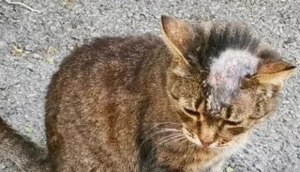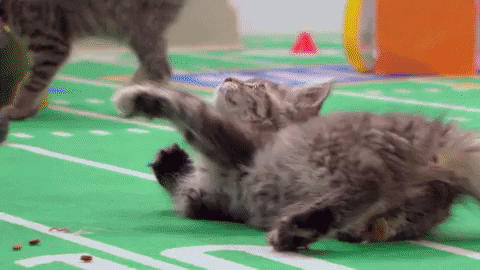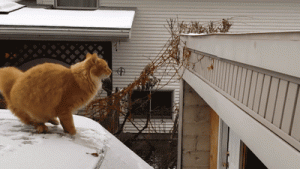For many cat owners, watching cat videos has become a regular part of their routine—whether it’s before meals or right before bed. Among the countless videos out there, the one that’s most popular is the “Silly Cat Compilation.” Some cats are simply awkward with their limbs, while others might have a simple mind. But there are also some who seem genuinely clueless: hitting themselves with their paws, kicking their own faces with their hind legs, and even landing punches. Every time I watch these videos, I can’t help but wonder: Why do they do this? Doesn’t it hurt? Could they actually be… just that silly?Currently, behaviorists and veterinarians have a few theories on why cats engage in this “self-inflicted” behavior:
-
It’s Just Hunting and Play Behavior
One common theory is that this behavior stems from a cat’s hunting instincts. When cats are hunting, they typically deliver a “killer bite” with their teeth. However, if they can’t overpower their prey with their teeth, they will often resort to kicking with their hind legs after biting (mouth) and scratching (front paws), a move commonly called a “rabbit kick.” This is why some cats, when startled or attracted by their own tail, may try to chase it, bite it, and uncontrollably kick at it… until they realize there’s no real danger, or they figure out their tail isn’t a prey item.
-
A Physical Reflex
Additionally, when in a vulnerable position, cats often expose their bellies to signal submission. But if the confrontation continues, they will inevitably engage in combat. In this situation, a cat in a lower position can use strong hind kicks to protect its soft belly while delivering a defensive strike. This is a self-protection mechanism inherent to cats’ bodies. When this protection reflex becomes conditioned, for example, if a cat is exposed with its belly up and feels threatened, or if its stomach is twisted in a certain way, it triggers this bodily “switch.” The hind legs will uncontrollably kick and flail, defending and protecting the soft belly. This behavior is similar to how some people, when they feel their life is in danger, will impulsively throw whatever they’re holding as a defense mechanism, even before their brain can fully process the threat. In response, cats may use “biting” as a pain stimulus, which overrides the kicking reflex and stops the “self-harm.” When the twist reaches a certain point, the hind legs begin to kick uncontrollably… but the “bite” serves as a reminder to lessen the force of the kicks.

-
For Relaxation
Some animal behaviorists speculate that, for certain cats, kicking themselves may actually be a way to experience pleasure. This sensation comes from the Meissner’s corpuscles in their skin, which are responsible for detecting touch, pressure, and vibrations. When these sensory receptors are stimulated, they create a sense of pleasure, much like the feeling humans get when brushing their hair or getting a head massage. So, after playing or running around excitedly, some cats might kick their hind legs a few times to activate these sensitive nerve endings and experience a sense of relaxation and reward. Alternatively, if a cat is feeling down, they may kick their legs to “encourage” themselves and regulate their emotions, similar to how people might kick a stone on the ground when they’re feeling frustrated.
-
It Could Also Be a Sign of Illness
While some veterinarians speculate that this behavior may be linked to conditions like hyperesthesia syndrome or OCD in cats, there hasn’t been any definitive medical research confirming this yet. Researchers at Cornell University’s Animal Hospital, in their studies of feline hyperesthesia syndrome, suggest that allergies, slipped discs, skin conditions, and other illnesses could lead to hypersensitivity in cats, triggering behaviors like tail-kicking. From a medical standpoint, behavior and severity need to be evaluated. If the cause of the behavior isn’t clear, symptom-based treatment should be considered.
Therefore, if your cat only occasionally kicks itself for fun, there’s no need to intervene. However, if you notice that your cat frequently kicks its own head or even causes injury, here are some steps you can take as a cat parent:Check Your Cat’s Facial Skin: Look for any abnormal signs like flakes, hair loss, or redness. This will help you determine if your cat is experiencing skin irritation or allergies.Observe Daily Behavior: Keep an eye on your cat’s regular activities and check for signs of excessive grooming or abnormal hair loss. This could indicate stress or a medical issue.Evaluate Your Home Environment: Consider any recent changes in your household—such as new furniture, changes in noise levels, or unfamiliar smells—that might be causing stress for your cat.Increase Playtime: Spend more time playing with your cat. Through regular interaction and care, you can help guide your cat’s behavior and see if this reduces or stops the “self-inflicted” behavior.Seek Medical Attention: If the above changes don’t seem to help, or if you suspect an allergy, it’s a good idea to take your cat to the vet for further examination and possible treatment.Has your cat ever shown any “silly” behavior? Feel free to share your stories!





